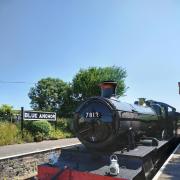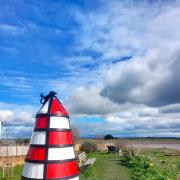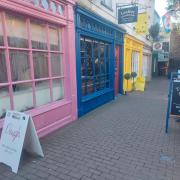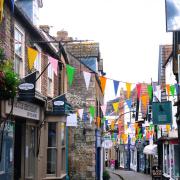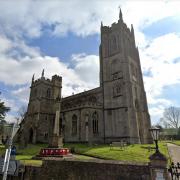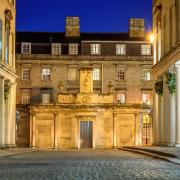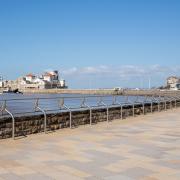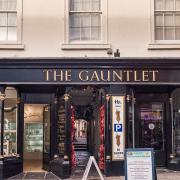Stephen Roberts searches for Arthur in the county

Victory swung first to one side and then to the other, until the battle of Badon Hill, when the Britons made a considerable slaughter of the invaders.” So wrote Bede in the early eighth century, describing an event that occurred about two centuries earlier, when Roman legions had departed Britain and these islands fell prey to marauding Anglo-Saxons, keen to fill the power vacuum.
Mons Badonicus (its Latin name) or Mount Baden, was one of those battles lost to us in the mists of time. Fought between the Celts (the Ancient Britons) and the invading Anglo-Saxons, Baden is oft represented as the last stand of Ancient Briton, when the Celts inflicted a crushing defeat on the Anglo-Saxons, halting their westward expansion for a generation.
If you believe the writings of Welsh cleric Nennius in the ninth century, one of the British leaders at Badon was King Arthur, and the battle one of 12 he allegedly fought against the Saxons. Welcome, King Arthur, Britain’s number one myth. Nennius doesn’t actually describe him as a king, but a leader instead, something repeated by the 10th century Welsh Annals, which date Badon to around 516-518 AD. What we have here is a generalissimo.
But where was Badon? No one knows for sure, though a West Country battlefield is favoured, with Wiltshire and Dorset sites posited. Somerset boasts a potential location, too: Little Solsbury Hill, near Bath. A Somerset Badon would be apt, for it is in our county where the so-called Dark Ages are being slowly enlightened by archaeologists’ discoveries. As a lost period emerges, I went to Little Solsbury to investigate.

It’s possible to drive almost to the top up a narrow track; I just prayed I didn’t meet anything coming down. There’s an information board at the foot of the final climb, which is made on foot. Further up is a National Trust sign and on the plateau, once an Iron Age hill fort, is a stone recording this land’s presentation to the Trust.
A buffeting from the wind made photography tricky, but the sun forced its way between clouds and illuminated views over Bath’s suburbs. Arthur is nowhere mentioned, but he may have been here.
Somerset claims the bones of Arthur, with his final resting place believed to be in Glastonbury Abbey. In 1191, during the reign of Richard the Lionheart, the monks of the abbey declared they had found Arthur’s bones together with the bones of his queen, Guinevere. They were allegedly digging between ancient memorial pillars in the churchyard, when they ‘stumbled’ across the King’s remains.
There are three Arthurs in this tale: an historic figure from the sixth century AD, the possible hero of Baden and the refashioned Arthur of Medieval times – an Arthur of fable, a regeneration myth fit for chivalry, knights and damsels in distress. Here come Merlin, Lancelot, the Knights of the Round Table and dare I say it, Guinevere too. Will the real Arthur please stand up.

Geoffrey of Monmouth completed The History of the Kings of Britain in 1136, in which he waxed lyrical about Arthur and his exploits, introducing a receptive Medieval public to the prophecies of the esoteric Merlin and the boy born to be king. Were the monks of Glastonbury cashing in on Arthur’s new-found cachet and throwing open their doors as a money-making pilgrimage site? We’ll never know, although we can suspect. In the public consciousness, however, Arthur and Glastonbury would be forever connected like south and north magnets.
Let’s not forget that in 1184, just seven years earlier, Glastonbury Abbey had suffered a fire. The abbey was on its knees. You can almost hear Brother Baldrick saying ‘I’ve a cunning plan’. Quicker than you could say ‘Holy Grail’, Glastonbury became the Isle of Avalon, Arthur’s supposed resting place, with its Tor handily peeking out like an island, as indeed it would have been a Millennium ago, when water levels were higher.
Avalon was called the Isle of Glass apparently; the plot thickens. Arthur’s Holy Grail was apparently the chalice from the Last Supper, earnestly sought by he and his knights and supposedly buried beneath the Tor, although it has also been linked to Chalice Well at the Tor’s base.
Just to throw in another curve-ball: some early chroniclers who wrote about Arthur say he visited Glastonbury in life, as well as death, and that some dispute with another chieftain was mediated here, probably by Glastonbury’s abbot. It was the abbot and his community benefiting most from Glastonbury’s newly discovered link to Avalon; the abbey became the country’s largest and wealthiest after Westminster.

By the time I got to Glastonbury, the clouds of earlier had headed elsewhere and the sky was postcard blue. I was drawn to the grave site, close to the abbey’s high altar. A plaque records that Arthur’s bones were removed to this prominent spot in 1278 in the presence of Edward I, but were then lost in the abbey’s 1539 dissolution. Wherefore art thou, Arthur?
As former Roman Britain and its towns declined, British leaders returned to old hill forts. South Cadbury is one such place, refortified in the fifth Century AD by an embattled local population, archaeological finds, including traces of a timber hall of the right era, confirm. Buildings here were occupied by someone important in the late fifth and early sixth centuries AD, the time when our supposed historic Arthur was fighting his battles. Could South Cadbury hold clues to the real Arthur? Is it the home of Camelot?
South Cadbury is one of two places in England (the other being Tintagel) that lays claim to the legendary castle. On day two of my quest, the cloud of yester morning returned, giving this place an atmosphere that I couldn’t articulate; like a place asleep. A place in which one could easily imagine King Arthur and his mythical knights prowling the streets. The locals aren’t shy about the claim. The village pub is The Camelot Pub and, according to the street sign, ‘Castle Lane’ is ‘leading to Camelot Fort’.
It was another 12th century writer, William of Malmesbury, who gave us perhaps the most compelling aspect of the whole Arthur story, that of the ‘once and future king’, the belief that Arthur would rise again at the time of his nation’s greatest peril. Maybe his time has been, or perhaps it is yet to come.




